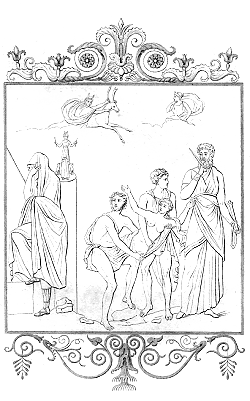|
|
Plate XLVI represents the sacrifice of Iphigenia at
Aulis. Chalcas had already taken the fatal knife, and
was going to immolate the virgin, when Diana, appeased
by the submission of Agamemnon, substituted a hind in
the place of the innocent victim. The goddess and the
animal are seen in the clouds.
In the original, the hard features of Chalcas are well
imagined. Many artists have complained that the feet of
Iphigenia are not seen, but they might have been
concealed by the male figure, and the ancients seem
seldom to have represented the limbs which were not
absolutely necessary.
Timanthes, of Sicyon, was highly applauded for having
painted a picture of this subject with the countenance
of Agamemnon hidden, the expression being beyond the
art of painting. He lived in the time of Philip of
Macedon ; but it appears that Polygnotus of Thasos, who
lived in the fifth century before Christ, had also
painted the same subject, and Euripides had imagined
it, with the same circumstances as those represented in
the temple at Delphi by Timanthes. It is very
satisfactory to have an ancient representation of any
subject the meaning of which admits of so little
dispute.
Iphigenia has a yellow drapery, and the two persons who
are holding her have mantles of a violet colour.
Chalcas has a purple dress, and over it, tied round the
waist, a yellow drapery.
Agamemnon has a long cloak of a dark-blue tint ; but,
notwithstanding the frequent use of purple in the
picture, the general effect produced by the whole is
red, the skin, the hair, and almost every thing
inclining to that colour.
The picture is invaluable, and was in good preservation
; but either that the subject is not agreeable, or from
some other motive, it is one of the least pleasing of
the paintings at Pompeii.
The oven of the fullonica is immediately behind
this picture, and it must be presumed that the heat
must have penetrated the wall, but the colours do not
seem to have suffered.
|
